
Mayflies are aquatic insects belonging to the order Ephemeroptera. This order is part of an ancient group of insects termed the Palaeoptera, which also contains dragonflies and damselflies. Over 3,000 species of mayfly are known worldwide, grouped into over 400 genera in 42 families.
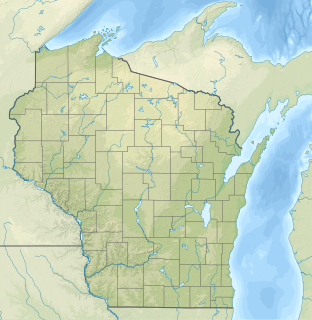
Sturgeon Bay is an arm of Green Bay extending southeastward approximately 10 miles into the Door Peninsula at the city of Sturgeon Bay, located approximately halfway up the Door Peninsula. The bay is connected to Lake Michigan by the Sturgeon Bay Ship Canal. The Potowatomi name for Sturgeon Bay is "Na-ma-we-qui-tong".

The Hare's Ear or Gold Ribbed Hare’s Ear is a traditional artificial fly imitating an aquatic insect larva (nymph) used in fly fishing.
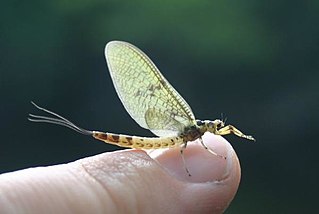
The name Palaeoptera has been traditionally applied to those ancestral groups of winged insects that lacked the ability to fold the wings back over the abdomen as characterizes the Neoptera. The Diaphanopterodea, which are palaeopteran insects, had independently and uniquely evolved a different wing-folding mechanism. Both mayflies and dragonflies lack any of the smell centers in their brain found in Neoptera.

Baetidae is a family of mayflies with about 1000 described species in 110 genera distributed worldwide. These are among the smallest of mayflies, adults rarely exceeding 10 mm in length excluding the two long slender tails and sometimes much smaller, and members of the family are often referred to as small mayflies or small minnow mayflies. Most species have long oval forewings with very few cross veins but the hindwings are usually very small or even absent. The males often have very large eyes, shaped like turrets above the head.
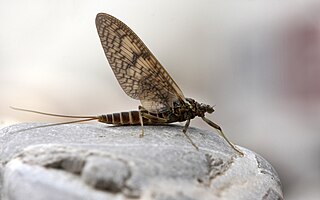
The Heptageniidae are a family of mayflies with over 500 described species mainly distributed in the Holarctic, Oriental, and Afrotropical regions, and also present in the Central American Tropics and extreme northern South America. These are generally rather small mayflies with three long tails. The wings are usually clear with prominent venation although species with variegated wings are known. As in most mayflies, the males have large compound eyes, but not divided into upper and lower parts.

Ephemeridae is a family of mayflies with about 150 described species found throughout the world except Australia and Oceania. These are generally quite large mayflies with either two or three very long tails. Many species have distinctively patterned wings.

"Reset" is the sixth episode of the second series of the British science fiction television series Torchwood, which was first broadcast on BBC Three on 13 February 2008.

Leptophlebiidae is a family belonging to the Ephemeropterans that are commonly known as the prong-gilled mayflies or leptophlebiids. It is the only family in the superfamily Leptophlebioidea. In North America they occur with about 70 species from 9 genera in freshwater streams and lakes; in Europe they are somewhat less diverse. Globally, this family is much more prevalent and diverse, with about 2000 different species. Leptophlebiids are easily recognized by the forked gills present on the larvae's abdomen, thus their common name.
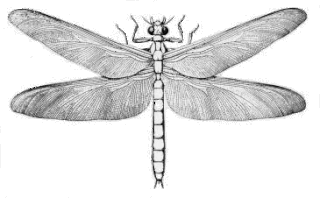
The Odonatoptera are a superorder of ancient winged insects, placed in the Palaeoptera which probably form a paraphyletic group however. The dragonflies and damselflies are the only living members of this group, which was far more diverse in the late Paleozoic and contained gigantic species, including the griffinflies of the order Protodonata. This lineage dates back at least to the Bashkirian, not quite 320 million years ago.
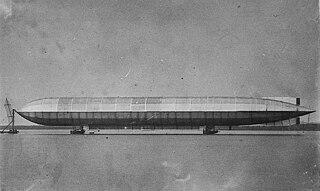
His Majesty's Airship No. 1 was designed and built by Vickers, Sons and Maxim at their works in Barrow-in-Furness, Lancashire, England, as an aerial scout airship for the Royal Navy. It was the first British rigid airship to be built, and was constructed in a direct attempt to compete with the German airship programme. Often referred to as "Mayfly", a nickname given to it by the lower deck, in public records it is designated ‘HMA Hermione’ because the naval contingent at Barrow were attached to HMS Hermione, a cruiser moored locally preparing to act as its tender.

Rhithrogena germanica is a European species of mayfly, and is "probably the most famous of all British mayflies", because of its use in fly fishing. It is known in the British Isles as the March brown mayfly, a name which is used in the United States for a different species, Rhithrogena morrisoni. It emerges as a subimago at the end of winter, and can be distinguished from similar species by a dark spot on the femur of each leg.

Cloeon dipterum is a species of mayfly with a Holarctic distribution. It is the most common mayfly in ponds in the British Isles and the only ovoviviparous mayfly in Europe. Males differ from females in having turbinate eyes.

Coxoplectoptera or "chimera wings" is an extinct order of winged insects containing one family, Mickoleitiidae. Coxoplectopterans are closely related to the mayflies.

The Holy Family with the Dragonfly, also known as The Holy Family with the Mayfly, The Holy Family with the Locust, and The Holy Family with the Butterfly is an engraving by the German artist Albrecht Dürer (1471–1528) from approximately 1495. It is quite small but full of intricate detail. A very popular image, copied by other printmakers within five years of creation, it is found in most major print room collections, including the Indianapolis Museum of Art and the UK Royal Collection.

Schistonota is a suborder of mayflies. One of the differences between this suborder and its sister group, Pannota, concerns the degree of fusion of the wing pads in the final-stage nymph; in Schistonota, the degree of fusion along the mesothorax is more than half the fore-wing length while in Pannota the degree of fusion is less than half that length. Other differences between the two groups include the morphology of the gills and also behavioural differences. Schistonota nymphs are mostly active swimmers, burrowers or sprawlers, while Pannota nymphs are more passive, slow-moving crawlers.

Pannota is a suborder of mayflies. One of the differences between this suborder and its sister group Schistonota concerns the degree of fusion of the wing pads in the final-stage nymph; in Schistonota, the degree of fusion along the mesothorax is more than half the fore-wing length while in Pannota the degree of fusion is less than half that length. Other differences between the two groups include the morphology of the gills and also behavioural differences. Schistonota nymphs are mostly active swimmers, burrowers and sprawlers, while Pannota nymphs are more passive, slow-moving crawlers.

Ephemera simulans is a species of mayfly. It is commonly found throughout the United States. The species is used for fly fishing.

Pisciforma is a suborder of mayflies in the order Ephemeroptera. There are at least 410 described species in Pisciforma.

Furcatergalia is a suborder of mayflies in the order Ephemeroptera. There are about 14 families and at least 1,700 described species in Furcatergalia.















